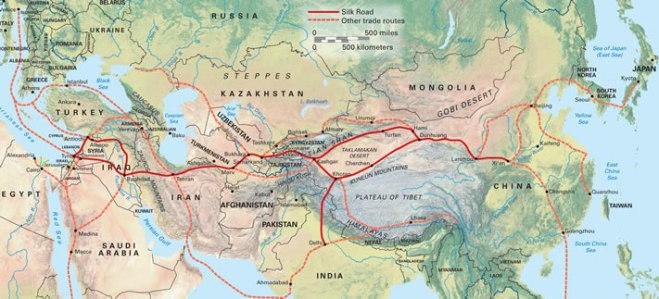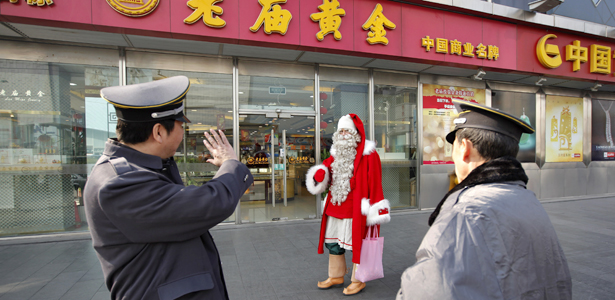Bangkok, 25 January 2016
I have a wonderful pair of jeans. I bought them God knows how many years ago and ever since, through a constant cycle of wearing and washing, they have softened, whitened, shredded, and micro-ripped. They are the very epitome of distressed jeans (“Distressed (of fabric): visibly aged and worn, from long, steady use, but still intact and functional”).
I laugh scornfully at those half-starved ladies who mince around in what are obviously fake distressed jeans, jeans that have been subjected to Lord knows what processes (stone washing, sand blasting, chemical bleaching, cutting, slashing, and on and on) in some sweat shop in a poverty-stricken part of the planet.
This pair of jeans are still relatively OK. The next pair seems to have been subjected to the tender mercies of Edward Scissorhands.
 Using a metaphor, my jeans are comparable to a great wine, aged over years in a cool cellar
Using a metaphor, my jeans are comparable to a great wine, aged over years in a cool cellar
while theirs are just alcopop.
 And the funniest thing is that my jeans cost me little, while theirs cost hundreds of dollars. Ha!
And the funniest thing is that my jeans cost me little, while theirs cost hundreds of dollars. Ha!
Actually, this business of cost, as well as the deliberate mutilation of the fabric that we see in the previous pictures, both give me pause. Let’s remind ourselves that until relatively recently the denim of my trousers, along with the closely related jean fabric, were almost entirely used to make work clothes for working people. Levi Strauss made his fortune manufacturing tough, long-lasting, affordable denim trousers for men like this: gold panners caught up in the California gold rush (the forty-niners, “was a miner, forty-niner, and his daughter Clementine”)
or for the miners in the gold and silver mines out in Colorado, Arizona, and Nevada
as well as, of course, for the cowboys who roamed the Western range.
In a word, jeans were made for tough men who worked in the great outdoors.
The original ads for Levi jeans gloried in this toughness. The company was making trousers that even horses couldn’t tear apart!
How did this tough, no-nonsense, affordable piece of clothing morph into expensive rags clinging to the legs of elegant, half-starved women? Tasteful rags, I grant you, and clean, but still rags.
Step 1 in this transformation, it would seem, was the dude ranch phenomenon. For those of my readers who don’t know what dude ranches were, they were working ranches in the American West, where city people from the East (called dudes by the locals) would come for a vacation to enjoy a romantic outing to cowboy land without having to suffer the discomforts and dangers of the original immigrants. The popularity of dude ranches soared after the First World War with the advent of the car and easier travel. Here’s the cover of a popular magazine from the early 1940s, which shows what most people probably thought of dudes (notice the laughing cowboys in the back). But what is of even greater interest to us is what this fashionable young lady is wearing – undoubtedly a pair of blue jeans.
When on the ranch, these city slickers (another term used for dudes, along with greenhorns and tenderfoots) clearly wanted to dress like the cowboys which they met there, and then they started bringing these exotic clothes back East: most readers probably don’t know that Levi jeans were not sold east of the Mississippi until maybe the 1930s or even 1940s. Presumably, though, it was still a small minority of Easterners who wore jeans and then only out in the countryside.
Step 2 in the transformation from a good, honest piece of clothing to an expensive rag was the adoption of blue jeans by Bad Boys – bikers and such, of which Marlon Brando in the 1953 film The Wild One became the epitome. Please note the scruffy jeans he is wearing.
James Dean, in the 1955 film Rebel Without A Cause upped the ante, in an equally scruffy pair of jeans but looking cuddlier than Brando.
(You see the jeans rather more clearly in this poster of the film)
Middle class parents hated everything about these films, including the jeans, therefore of course their teenage children loved them. It didn’t help that righteous school principals, cinema managers, and the like were banning jeans from their premises. That just added fuel to the fire.
The wearing of jeans as a sign of youthful rebellion, and of being youthful generally, culminated in the 1960s with the surfing, the flower power, the anti-Vietnam War movement of that decade. Here, for instance, is a hippie couple getting hitched – “married” would not be the correct word I think. I throw the photo in because the officiator is wearing a fine pair of jeans.
And here’s one of the gigs at Woodstock, where most of the band members seem to be wearing jeans. Note the serious flare on the jeans in the back of the photo – my very first pair of jeans, which I must have bought in the early ’70s, were so flared.
Even when things turned ugly, as they did in Kent State a year after Woodstock, jeans were being worn. I think everyone in this photo, including the Dead Student, is wearing jeans.
Note also how the Mourner has adorned her jeans with graffiti (art work is too big a word) – something which jeans wearers of the ’60s liked doing and something which the fashion world caught on to quite quickly. Already in the latter half of the ’60s, a New York boutique called Limbo hired impoverished, out-of-work East Village artists to embellish its jeans with patches, decals, and other touches, and sold them for the-then princely sum of $200. Jeans wearing was on the way to becoming trivialized.
By this point, I think it’s safe to say that jeans had pretty much entered the mainstream. The definitive proof of that is that I, who was never that alternative, was wearing them. They were still casual wear rather than formal wear, but they had “arrived”. There was, however, still an important step to take, namely the wearing of ripped jeans. I suppose we’re so used to wearing anything nowadays that the sight of ragged clothes on obviously well-off people doesn’t shock us. But not all that long ago, and by that I mean in my lifetime, wearing ripped and ragged jeans would have meant only one thing: you were poor, if not downright down-and-out. To stress this point, let me throw in here a picture of a painting by an unknown Italian artist of the late 17th Century, who goes by the soubriquet of “The Master of the Blue Jeans”. He is so known because of the ten or so paintings which are known to be from his hand, and which all have as their subjects people (poor people I should add) wearing blue jean fabric.
As readers can see, the child in this painting is very obviously poor, and the jean jacket which he is wearing is ripped. In today’s world, this child could probably sell this garment for a good price (after a strong fumigation and a good wash I would think). But in his day, and indeed even today in many parts of the world, ragged clothes meant poverty. Which is why my grandmothers obsessively darned and mended every hole they found in our clothes. And which is why there are many paintings recording this part of a woman’s work.
Yet in some mysterious way, some two-three decades ago it started to become chic, at least in certain circles, to wear ragged denim. Why?
It seems that we have the punks to thank for this. It was they, with their anti-conformist, anti-establishment, anti-everything attitudes who popularized the slashing of jeans. This picture gives a good example of the genre – both punks and slashed jeans.
I suppose slashing one’s jeans was just another, very obvious, way of giving the finger to our social conventions, in this case that rags were shameful; no doubt punks’ mums were horrified to see their children going around in rags and were mortified by what the neighbours might think.
But why didn’t this fashion statement just remain in the shadows of the sub-culture of punk? To answer that, I think we must acknowledge a modern trend in the fashion world. For centuries, the trend setters in fashion were the social elites, people like Louis XIV
or Beau Brummell, intimate of the Prince Regent, later George IV
or Edward VII, inventor of, among other things, the Homburg hat
or even someone like Mona Bismarck, American socialite of the 1930s
Beginning in the 1930s, though, we can see a shift towards a less elitist view, with film stars, for instance, becoming fashion trendsetters. By the 1960s, the shift seems to have been complete. The fashion trendsetters are now people on the street, like the punks, who are pushing fashion boundaries. Which has brought not just rag-wearing but also body-piercing and tattooing into the mainstream.
Personally, I think an important but overlooked element in the road of rags to riches is the introduction of an elastic component like spandex into the denim, which has allowed jeans to become very tight around the leg. Let’s face it, while the punks may have been giving us all the finger, the fashion industry doesn’t want to do that. It wants slashed jeans to send a nice message, and what’s nice about slashed jeans is that it allows one a sight of the shapely legs of the half-starved women inserted in those jeans. And one doesn’t get a good sight of the legs unless the jeans adhere tightly to them.
That, I think, concludes the journey of jeans from serious work clothing to chi-chi vestment. What can be next, I wonder? Well, there is talk of jeans disappearing altogether. Many young things, it seems, are opting more and more for the cute sounding athleisure, which is cutting into jeans’s traditional markets. If this goes on, everyone will be dressed like this
or this
or other variations, and Levi Strauss will either be making these or will have gone out of business.
I must keep my jeans for another 30 years. They will probably be a very rare piece by then and be worth a fortune.
______________
My jeans: my photo
Woman wearing “distressed jeans”: http://4.bp.blogspot.com/-4r9MHsbshO8/VLuo7CuxZBI/AAAAAAAA36s/sTB-FnG5_a4/s1600/Distressed%2BDenim.jpg (in http://www.over50feeling40.com/2015/01/would-you-wear-it-wednesday-distressed.html)
Extremely distressed denim: http://www.aliexpress.com/item/Women-s-Vintage-boyfriend-slouchy-Big-Ripped-Destroyed-Washed-Out-jeans-Denim-Distressed-punk-rock-trousers/1867914655.html
Bottle of good wine: https://s-media-cache-ak0.pinimg.com/736x/7e/71/99/7e71991ec3b450efa2b50d7923cdb1f5.jpg (https://www.pinterest.com/pin/196539971211872465/)
Bottle of alcopop: http://drink-brands.com/drinks/wp-content/uploads/2012/03/SourzFusionzAlcoholicDrink.jpg (in http://drink-brands.com/drinks/alcoholic-drink/sourz-bring-out-sourz-fusionz-bottled-drink/)
Gold panner: http://www.legendsofamerica.com/we-mininggold.html
Gold miners: http://www.mcmahanphoto.com/lc548–montanamineoldwest1889goldminersphoto.html
Cowboy: http://www.old-picture.com/old-west/Cowboy.htm
Old Levis poster: https://equigeoblog.wordpress.com/tag/horse-logos/
Woman dude: http://debyclark.blogspot.my/2012/06/20-june-1942-woman-at-dude-ranch.html
Marlon Brando in The Wild One: http://leblow.co.uk/fashspiration-of-the-week-kate-moss-on-a-motorbike/
James Dean in Rebel Without A Cause: http://www.grimygoods.com/2014/03/06/12-best-iconic-mens-vintage-biker-leather-jackets/
Rebel Without A Cause poster: http://www.imdb.com/title/tt0048545/
Hippies getting married: http://s192.photobucket.com/user/Swinging_Sixties/media/1960s/Hippies.jpg.html
Woodstock: http://www.woodstock.com
Kent State shooting: https://www.aclu.org/blog/speak-freely/flowers-are-still-better-bullets-45-years-after-kent-state-massacre
Boy in jeans jacket: http://tmagazine.blogs.nytimes.com/2011/01/11/vintage-jeans/?_r=0
Woman darning socks: http://stilllifequickheart.tumblr.com/post/35997420012/wybrand-hendriks-interior-with-wife-mending-socks
Punks: http://ellorajones.blogspot.com/2011/06/punk-rock.html
Louis XIV: https://en.m.wikipedia.org/wiki/Louis_XIV_of_France
Beau Brummell: https://en.m.wikipedia.org/wiki/Beau_Brummell
Edward VII: http://blog.sekora.cz/?tag=edward-vii
Mona Bismarck: https://www.pinterest.com/ccmfarrow/power-of-style-mona-countess-of-bismarck/
Athleisure-1: http://www.ocreurope.com/athleisure-a-growing-trend-in-fitness-fashion/
Athleisure-2: https://www.theodysseyonline.com/sleepy-style-fashion














































































